Helicopter Operational Terms
0) : ?>The main rotor is the rotor that rotates on the horizontal plane. The main rotor turns at speeds of 290-324 RPM. Conversely, the tail rotor is the smaller rotor in the rear of non-tandem rotor helicopters, which rotates on the vertical plane. The tail rotor generally turns between 1,500 – 1,800 RPM, making it impossible to see while in motion, especially at night! The cabin is defined as the internal portion of the helicopter where pilots and passengers are seated.
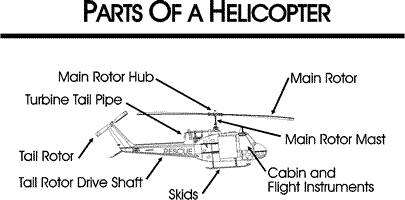
Rotor Systems
There are two basic helicopter designs, the single main rotor helicopter or the dual or tandem main rotor helicopter. The most common design uses a single main rotor, which imparts lift and thrust, and a smaller tail rotor, which compensates for torque induced by the powered turning of the main rotor.Some helicopters have dual main rotors, mounted in tandem, side-by-side or one above the other. Torque compensation is achieved by having the two rotors turn in opposite directions.
Helicopter Controls
There are four controls that are used in conjunction with each other when flying a helicopter.Collective Pitch Control
The "Collective Pitch Control" changes the angle of pitch (or angle of attack) of each main rotor blade simultaneously.
As the pitch of the blades is increased, lift is induced, causing the helicopter to lift off the ground, hover, or climb as long as sufficient power is available and air density is available.
Throttle Control
A handgrip throttle is mounted on the collective pitch stick for coordinated use on piston engine helicopters. The throttle increases or decreases the rate of revolution of the main rotor blade. As the pitch is increased, power must be added to maintain rotor RPM when the helicopter lifts off or climbs. On turbine-powered helicopters, this power coordination is accomplished automatically through the fuel control and governor systems of the turbine engine.
Anti-torque Control
Two anti-torque pedals counteract torque effect by providing a means of changing pitch (angle of attack) of the tail rotor blade(s). As a result, pedal action will provide heading and directional control in hover and at low airspeeds. The amount of torque varies with changes in power.
On dual rotor helicopters, the problem of torque control is solved through the counter-rotation of the main rotor blades, thereby accomplishing heading and directional control in a hover. With forward movement, the pilot must blend pedal action with his/her other control movements to produce a coordinated flight.
Cyclic Control
Directional movement of the helicopter (including bank during turns) and speed in forward flight are achieved by use of the "Cyclic Control." The main rotor system is tilted in the direction of the stick movement.
Landing Gear
Several types of landing gear are found on helicopters. Each type of landing gear provides a specialized functionality to the ship. The most common types of landing gear are detailed below:
Retractable Landing Gear
Some of the more refined helicopters are equipped with landing gear that may be retracted during flight. The helicopter, therefore, becomes more aerodynamic.
Skids
Skids are the most common type of landing gear used in light- and medium-class helicopters. Skids are permanent, non-retractable horizontal "feet" which provide a long, flat touchdown surface for the helicopter. Tundra pads and snow pads may be used for weight distribution when landings are required in areas where helicopter weight may cause the ship to settle on landing.
Wheels
Wheels are primarily used on medium- and heavy-class helicopters. Helicopters with wheels may be capable of movement on the ground when, for example, repositioning at a heliport is necessary.
Floats
Floats can be used on land as well as water. There are two types of floats, "fixed" and "inflated."
Principles of Helicopter Flight
Certain terms are commonly used in reference to the principles of helicopter operations. Familiarity with these terms is important to personnel involved in heliport operations.
Ground Effect
Ground effect is a condition of improved performance encountered when operating near the ground. It is due to interference between the airflow pattern of the rotor system and the ground. The interference is more pronounced the closer the helicopter is to the landing surface.
In-Ground Effect (IGE)
IGE occurs to its greatest extent approximately one-half of the rotor diameter above the ground. The ground alters the airflow pattern around and through the rotor system. With IGE, the airflow velocity through the rotor system is reduced, as is the drag associated with that velocity. Further, rotor tip vortex generation is reduced. Thus, the lift needed to sustain a hover can be produced with less power.
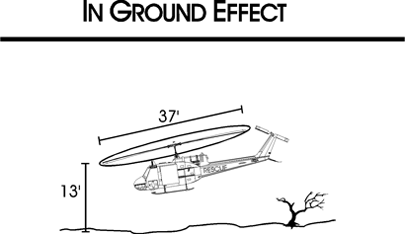
Out of Ground Effect (OGE)
OGE occurs when the helicopter rotor downwash is not affected by the proximity of the landing surface. In other words, OGE usually occurs when the helicopter is more than one-half of the rotor diameter above the ground.
It stands to reason, therefore, that some helicopters can lift less of a payload by sling than they can when the payload is on board the chopper. The reason is that lift by sling occurs while in OGE.
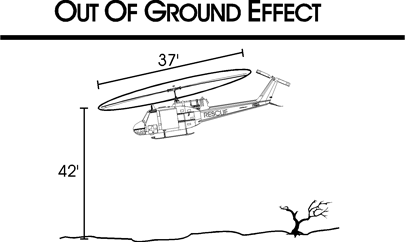
Normal Takeoff
Normal takeoff is the procedure used where flight of the helicopter is not limited by the presence of obstructions—natural or man-made. The normal takeoff procedure is made into the wind to obtain maximum airspeed with minimum ground speed.
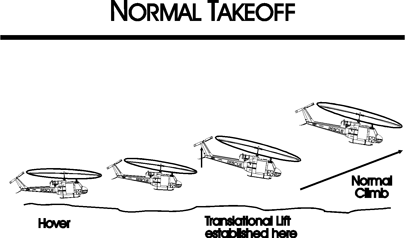
Translational Lift
The efficiency of the hovering rotor is improved with each knot of airflow gained by horizontal movement of the surface wind. As increasing velocities of airflow enter the rotor system, turbulence and vortices are left behind and airflow becomes horizontal. This improved rotor efficiency resulting from directional flight is called "translational lift." In effect, this is the lift that is obtained from translation from a hover to forward flight. It is felt as a "shudder" in the aircraft.
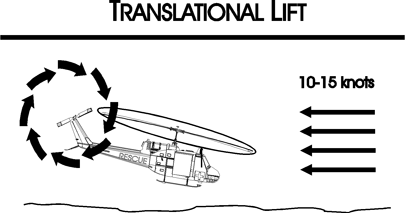
Effective Translational LiftAt airspeeds between 10 and 15 knots, depending on the model of helicopter, the rotor completely outruns the recirculation of old vortices and begins to work on clean air. Effective translational lift results.
Maximum Performance Takeoff
"Maximum performance takeoff" is the takeoff procedure used when departing a confined area, that is, where flight of the helicopter is limited by terrain or other obstructions. During the maximum performance takeoff, little use can be made of ground effect or translational lift until the obstruction has been cleared. Thus, the rotor system is less efficient and greater demands are placed on the power plant, with less remaining power left as a safety margin. This explains why hover holes and confined helispots should be avoided, whenever possible. Remember that the greatest strain on a helicopter’s engine occurs during landings and takeoffs, and hover holes and confined helispots leave little room for error.
Autorotation of Helicopter
"Autorotation" is the term used for the flight condition during which no engine power is supplied to the rotor system and sustained flight is possible from the rotor blades. The pilot can use the inertia for collective pitch to slow the rate of descent and effect a safe landing. Unlike fixed wing aircraft, rotor wing aircraft are capable of controlled landings during most conditions when power is lost; assuming a suitable landing surface exists below the helicopter. Helicopter pilots often train in autorotation landings.

Height-Velocity Chart
Each helicopter flight manual contains a "Height-Velocity" chart, which indicates speeds and altitudes to be maintained so that a safe autorotation may be made in the event of a mechanical or electrical failure. At speed/altitude combinations below the curve in the "caution" areas of the chart, the helicopter would be difficult to safely autorotate. For this reason, the Height-Velocity Chart has been given the nickname "Dead-Man’s Curve."
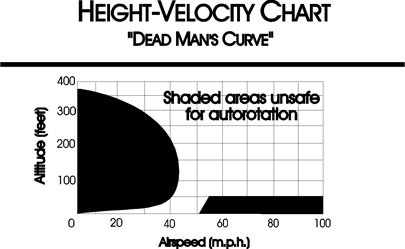
Density Altitude
A large number of search and rescue operations requiring helicopters occur at times of high temperature, high humidity, and at high elevations (subsequently low air pressure). Unfortunately, each of these three variables negatively effects the performance of a helicopter.
Density altitude, which is the effect on aircraft by these three variables (temperature, humidity and air pressure), is an important issue that must be considered by the team’s leadership. A helicopter cannot work as effectively at higher altitudes as it can at sea level. The effect of increased temperature would be similar to increasing the elevation to which the chopper must now fly. On a hot day, the density altitude at a particular location may be 2,000 or even 3,000 feet higher than the elevation of that location. Increased humidity has an effect, albeit a minor one, on density altitude as well.
In technical terms, therefore, "density altitude" is pressure altitude corrected for temperature and humidity. All three factors (air pressure, temperature and humidity) affect the density altitude in varying degrees. The higher the density altitude, the weaker the helicopter performance. High elevation (e.g. reduced pressure), high temperature and high humidity all contribute to higher density altitudes. Performance is reduced because the thinner air at high-density altitudes reduces blade efficiency. This, in turn, requires additional pitch and power to maintain the same lift capability. The greater pitch angle results in increased drag that requires additional power. Un-supercharged piston engines and turbines also operate less efficiently in this less dense air.
A high-density altitude can result in loss of engine power, reduced lift and reduced payloads. This would mean that the helicopter would require longer takeoff and landing rolls and would experience a decreased rate of climb. Of the three variables listed above, humidity plays a very minor role in determining density altitude.
Density altitude is one reason why helicopter pilots may prefer to fly in the early morning hours. It also explains why a pilot, whose chopper is full of fuel, may wish to fly with only one passenger at a time. Most importantly, density altitude is the entire reason why consideration of the need for helicopters during search and rescue missions should be made early in the day, since flying conditions may be less than ideal during the afternoon hours.
Loss of Tail Rotor Effectiveness
The pilot controls the helicopter’s tail rotor with pedals operated by his/her feet. When the anti-torque provided by the tail rotor is insufficient to counteract the torque of the main rotor, the ship experiences the condition called "loss of tail rotor effectiveness." The helicopter will begin a spin, albeit potentially a slow one. This is a dangerous condition. It is more common in situations of high altitude, high temperature and/or heavy loads.
Contact a Helicopter Lawyer
If you have been injured or a loved one has been killed in a helicopter crash, then call us 24/7 for an immediate consultation to discuss the details of the accident and learn what we can do to help protect your legal rights. Whether the accident was caused by negligence on the part of the helicopter owner, hospital or corporation, the manufacturer or due to lack of training, poor maintenance, pilot or operator error, tail rotor failure, sudden loss of power, defective electronics or engine failure or flying in bad weather conditions, we can investigate the case and provide you the answers you need. Call Toll Free 1-800-883-9858 and talk to a Board Certified Trial Lawyer with over 30 years of legal experience or fill out our online form by clicking below:
0) : ?>
